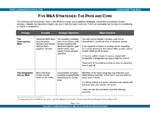
Categories
Five Merger & Acquisition Strategies: The Pros and Cons
$9.95
In stock
Five Merger & Acquisition Strategies: The Pros and Cons
Product Details
This tool lays out the pros and cons of five different merger and acquisition strategies. It provides an example of each strategy, it details the objectives of each one, and it lists the major concerns. This is a valuable tool for anyone considering a merger or acquisition. (3 pages)
Join the LRI Newsletter to receive free tools and expertise to improve your business.
Five Merger & Acquisition Strategies
Strategy 1: The Overcapacity M&A
Example: Chemical Bank buys Manufacturers Hanover and Chase; Daimler-Benz acquires Chrysler.
Strategic Objectives: The acquiring company (part of an industry with excess capacity) will eliminate capacity, gain market share, and create a more efficient operation.
Major Concerns: You can’t run a merged company until you’ve rationalized it, so decide what to eliminate quickly. If the acquired company is as large as the acquiring one and its processes and values differ greatly, expect trouble. Nothing will be easy. If it is a so-called merger of equals, expect both companies’ management groups to fight for control. These tend to be onetime events, so they’re especially hard to pull off.
Strategy 2: The Geographic Roll-Up M&A
Purchase to download the rest of this tool.
